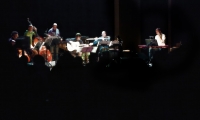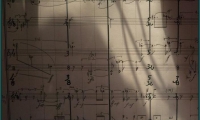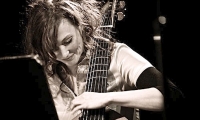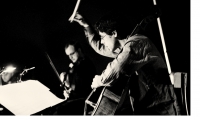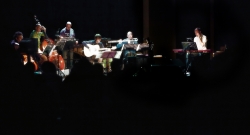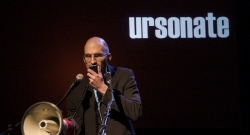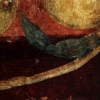CAST
Eva Reiter : viola da gamba, Paetzold flute
Thomas List : flauto dolce
Theresa Dlouhy : voice
Ictus : Geert De Bièvre, George van Dam, Jean-Luc Plouvier, Jeroen Robbrecht, Michael Schmid, Chryssi Dimitriou, Tom Pauwels
Sound : Alexandre Fostier
Coordination : Wilfried Van Dyck
Production : Kaaitheater, Bozar, Ars Musica

PROGRAMME
Franck Yeznikian : Liquid room subtilior for clavichord, guitar, string trio and electronics (premiere)
Christophe Guiraud : Le déchirèrent, chantant encore, et çà et là dispersèrent ses membres pleins d'harmonie for bass flute, recorder, Paetzold recorder, string trio, celesta and electronics, on three stages (premiere)
Gérard Pesson : La Lumière n'a pas de bras pour nous porter, (1995) for amplified piano
Bernhard Gander : 2Bad (2012) for electric guitar and viola da gamba
Bernhard Gander : Darkness awaits us (2013) for voice and viola da gamba
Pascal Dusapin : Quatuor #5 (2005, excerpt)
Heinz Hölliger : Lied for amplified solo flute (1974)
Conlon Nancarrow : Study 6 in an arrangement for 6 musicians
Michael Schmid : Montage of spoken word works based on the Voynich Manuscript
György Kurtag : Ligatura-Message to Frances-Marie, The Answered-Unanswered Question (1989) for double bow cello, celesta and two violins
Jean-Luc Fafchamps : Z1 (2003) for viola, piano and electronics
Lorenzo Pagliei : Duet of virtual percussion (2014)
Jürg Frey : 2nd Quartet (2000)
Francesco Landini : Aquila altera
Philippotto de Caserta : En atendant
Johannes Ciconia : Sus une fontayne
Johannes Ciconia : Una Panthera(instrumental)
Antonello de Caserta : Amour má le cuer mis
Bartolino da Padova : Imperial sedendo

GUESTS
For this fifth LIQUID ROOM instalment, we are inviting three members of the outstanding Viennese ensemble MIKADO, specialising in medieval and Renaissance music: Thomas List playing the recorder, Theresa Dlouhy singing, Eva Reiter playing the hurdy-gurdy. Reiter, it should be stressed, is also a first-rate gamba player and flautist (specialising in the contrabass recorder or Paetzold recorder), and this is not the first time Ictus has collaborated with this artist.
SUBTILIOR
The term Ars Subtilior was first suggested in 1960 by the musicologist Ursula Günther, as an affirmative alternative for referring to the latest development of Ars Nova music in the late 14th century, which up until then was saddled with the somewhat sceptical label of "Mannerist style". Subtilis, Subtilior, Subtilitas: these terms are peppered throughout the writings of Philippus de Caserta and Egidius de Murino. These two composers are fairly representative of this refined movement that came into being against the background of the seigniorial courts in the South of France. The "Subtlety" obviously conjures up a whole world of subtle melodic and rhythmic distinctions, delicacy of phrasing, the refinement of longing typical of courtly love. While also being evocative of skills, science, writing for pleasure, formal accomplishment, everything now referred to as the "art of constraint": polytextual counterpoints blending various lyrical effusions expressing different viewpoints, calligrams, quotations, self-quotations, irony; overlapping metres (9/8 over 5/2 over 7/3, for example, in the case of Cordier) and various modes; rhythmic instability by intensive use of syncopation “which fails to resolve”; high velocity of the upper voice; numerous alterations creating a chromatic atmosphere and, above all, creating the impression of a high level of vocal autonomy that is embodied in the polyphonic texture only with a cavalier attitude. (1)
The extent to which medieval and Renaissance music infused contemporary post-war music is well-known. A memorable example is the lovely story by Luigi Nono, referring to the impassioned evenings spent with Bruno Maderna, trying to decrypt the enigmatic canons written according to the magic quadrant rules. The formal investigations of pre-tonal music inspired the post-tonal ones, as a guarantee that the strictest sets of constraints were completely consistent with the delicate passion of an aristocratic expression. For them the Subtle acted as a talisman, a spiritual shield as protection against the romantic sentimentality they were both drawn to and repulsed by and from which they sought an escape route. Being reconciled with the 19th century, we still continue to be charmed by the strange affinities of the 14th and 20th centuries. It is a bit like a guild, a Subtle Alliance
(1) N.B.: our friends, partners and fellow occupants of the Rosas dance company's premises, headed by Anne Teresa De Keersmaeker, have devoted two splendid performances to Ars Subtilior music: En Atendant (2010) and Cesena (2011).
NIGHT
Our Viennese friends are offering us Landini, Caserta, Ciconia: the expression and the sound of a period that are so near and yet so far away. In exchange for which we propose contemporary music – from Klaus Huber to Bernhard Gander, via Conlon Nancarrow – as well as two pieces especially written to mark the occasion (Franck Yeznikian and Christophe Guiraud), where we blend modern and old instruments in unusual combinations: clavichord and electronic sounds, for example – and lashings of flute, all kinds of wooden and metal flutes.
We are not trying to compete with Ars Subtilior, to outdo it in terms of ostentatious intricacy and manic polyphony. We delved into the "nocturnal" repertoire to choose (and commission) contemporary work. In order to be Subtilior, a formal unleashed attitude has to be delicately combined with a restrained form of expression. Experimental music and modest singing are not strange bedfellows: quite the contrary, they make a smooth blend to be filed under Enigmatic. Associating with medieval enchantments, contemporary music will reveal its least well-known side, even though this is perfectly consistent with its history: when the gentle expression, refined tones, intertwining polyphonic lines and varied ornamentation are combined to form a kind of “peaceful evening”, where the shadows are our friends and fragility a badge of honour. The listener stands on guard, forgetting the diurnal disturbances, rediscovers music as the art of the half-said and a discipline of Secrecy.
PROGRAMME
This lengthy programme will unfold in a single curve on four sets, according to the rules of echo. cross-fading or contrast... As is the wont in the Liquid Room, the programme provided to the audience features the works and their commentaries in disorder or alphabetic order. The titles of the pieces performed will then be projected in real time onto a giant screen (with the texts of the sung works, where appropriate).
The medieval works and the two new pieces will form the nucleus. The combination of accompanying works might be subject to minor changes. Date: March 2014, Kaaitheater, festival Ars Musica / Klara Festival (co-produced with Bozar and Kaaitheater), Brussels.
THE LIQUID ROOM FORMAT
Ictus' "Liquid Rooms" represent a format of presentation over and above their role as a repertoire reservoir. The tiers of seats are removed from the concert hall, while four stages are arranged along the walls. The audience members are free to adopt whichever position they like. They can stroll around, remain standing, loll about on the floor or make use of one of the 100 small mobile cardboard stools we provide... They are also at liberty to take advantage of our "open door" policy by circulating between the bar and the hall. Everything is smoothly linked together, such that the musicians can be seen limbering up for their turn on one stage while their colleagues are busy performing on another one. The stage management ticks over perfectly, just like a theatre play: the amplification and lighting create a moon-like atmosphere. As a result of all these careful preparations, the members of the audience are regaled with an uninterrupted flow of music lasting at least two hours. Set changes are banished from the Liquid Room, where the fine-tuned linkages are achieved as a result of changing over from one set to another. Each performance is an extension of its predecessor, either commenting on the earlier one or contradicting it via a contrast-enhancing effect.
The repertoire unveiled to the public is generally of the chamber music ilk, ranging from a soloist to a sextet, with the focus being on the individual performance, physical dexterity, concentration and the privileged instance. Developing their shapes and shaping their tempos, the "works" in the true sense of the term alternate with Cagian-style "performances", where the emphasis is generally on the zero time prized by Christian Wolff, circular time as sheer contemplation on sound. Serving to highlight the relationship to the instrument and the ability to master an idiom, the acoustic performances also alternate with interdisciplinary music for instruments and electronic sounds. The latest generation of composers have taken this style to such an extreme that "rock" and "academic" music have become indistinguishable. The audience is encouraged to switch its auditory attention in line with the way the repertoire switches from one stage to another: the casual listening of the festival-goer, the meditative listening of the soundscape enthusiast, the attentive listening of the music lover, the critical listening of the musicologist...
The Liquid Room experience has led us to this unexpected finding: the scope for pacing up and down in a large hall so as to switch from one stage to another – to listen very close-up or further away, to choose when and how to listen, to head to the bar and head back – in a nutshell, the kind of freedom you do not expect to find during a classical concert actually enhances the audience's attention, makes them more alert, strangely enough. They are allowed to observe and discover. Some younger audience members, for example, were seen with their noses almost pressed against the instrument of our cellist playing Helmut Lachenmann's Pression – while we personally had the opportunity to rediscover this work, its choreographic and acoustic impact, as if it had actually been designed for this kind of forum.
Liquid Room V: Subtilior, in March 2014 at the Kaaitheater in Brussels, is set to be the 10th instalment, in the wake of three other Brussels outings (Kaaitheater, 2009, 2011, 2013), and six others at the following venues or festivals: Bruges (Concertgebouw, 2009), Vienna (Wien Modern, 2009), Hamburg (Kampnagel, 2012), Darmstadt (final concert Internationale Ferienkurse, 2012), Luxembourg (Grand Théâtre, 2012), Ghent (Handelsbeurs, 2012).
+Darmstadter Echo, 30.Juli 2012, von Thomas Wolff
(...) It rolled, it foamed and boiled in the Darmstadium: With the three hours lasting event "Liquid Room" the '46th International Summer Courses for New Music' celebrated furiously their closing night, sailing public of around 900 over a lake of experimental sounds.
Voor deze 5de editie nodigen we drie leden uit van het Weense ensemble MIKADO, gespecialiseerd in muziek uit de middeleeuwen en de renaissance: Thomas List (blokfluit), Theresa Dlouhy (stem) en Eva Reiter (vedel). Reiter is trouwens ook componiste en een eersterangs gambiste en fluitiste (gespecialiseerd in de Paetzold contrabasblokfluit).
SUBTILIOR
De term ‘Ars Subtilior’ werd in 1960 door de musicologe Ursula Günther voorgesteld als benaming voor het absolute hoogtepunt van de Ars Nova (eind 14de eeuw), een stijl die tot dan toe sceptisch als maniëristisch werd bestempeld. Subtilis, Subtilior, Subtilitas: deze termen vinden we vaak terug in de teksten van onder meer Philippus de Caserta en Egidius de Murino, twee typische vertegenwoordigers van deze geraffineerde stroming die zich ontwikkelde aan de hoven van Zuid-Frankrijk. Achter dat subtiele gaat een hele wereld van melodische en ritmische nuances schuil, verfijnde expressie en een sublimering van het verlangen dat zo typisch is voor de hoofse liefde. Subtiliteit wijst echter ook op handigheid, wetenschap, schrijfvondsten en formele krachttoeren, kortom, op alles wat we vandaag als ‘artificiële kunst’ zouden bestempelen: polytekstuele contrapunten die verschillende gedichten vermengen met diverse perspectieven, kalligrammen, citaten, ironie; opeenstapelingen van verschillende metrums (9/8 op 5/2 op 7/3 bijvoorbeeld, bij Cordier); onstabiele ritmiek door intensief gebruik van de zich niet oplossende syncope; virtuoze bovenstemmen; tal van alteraties die een chromatische sfeer creëren en vooral de indruk geven van zeer autonome stemmen, die met soevereine achteloosheid verstrengelen tot een polyfoon weefsel. (1)
Het is een bekend gegeven hoezeer de middeleeuwse en renaissancemuziek de naoorlogse hedendaagse muziek heeft beïnvloed. Denken we bijvoorbeeld aan het mooie verhaal van Luigi Nono over zijn lange avonden met Bruno Maderna, waarbij ze raadselachtige canons ontcijferden, geschreven volgens de regels van het magische vierkant. De formele zoektocht van de pre-tonale muziek voedde op zijn beurt de post-tonale zoektocht en bood de garantie dat zelfs de meest formele kunstgrepen perfect verzoenbaar waren met de verfijnde passie van de aristocratische expressie. Het subtiele fungeerde voor hen als talisman, als spirituele bescherming tegen romantische sentimentaliteit, die hen tegelijk fascineerde en afstootte, en waarvoor ze een uitweg zochten. Verzoend met de 19de eeuw, blijven we echter gecharmeerd door de bizarre raakvlakken tussen de 14de en de 20ste eeuw. Alsof ze er een subtiele alliantie bestaat tussen die twee tijdvakken.
(1) Opmerking: onze vrienden, partners en medehuurders van bij Rosas, onder de bezielende leiding van Anne Teresa De Keersmaeker, wijdden twee schitterende voorstellingen aan de ‘Ars Subtilior’-muziek: En Atendant (2010) en Cesena (2011).
NACHT
Onze Weense vrienden brengen ons Landini, Caserta en Ciconia: de expressie en de sonoriteit van een tijdperk dat tegelijk zo dichtbij en zo veraf ligt. We dienen hen van antwoord met nieuwe muziek: van Klaus Huber tot Conlon Nancarrow en Bernhard Gander, plus twee speciaal voor de gelegenheid gecomponeerde stukken (Franck Yeznikian en Christophe Guiraud) waarbij we moderne en oude instrumenten op originele manieren combineren: klavichord, elektronica en allerlei soorten houten en metalen fluiten.
Het is niet onze bedoeling te rivaliseren met Ars Subtilior door er nog een schepje bovenop te doen als het gaat om ostentatieve complexiteit en uitbundige polyfonie. We hebben de moderne werken integendeel gekozen (en ook 'besteld') binnen het ‘nocturne’-repertoire. Om Subtilior te zijn, moeten de gedurfde formele vondsten een elegant geheel vormen dankzij een ingehouden expressie. Experimentele compositie en ingehouden zang zijn niet onverzoenbaar, integendeel: ze vloeien vlot samen binnen de categorie van het mysterieuze. Door te verbroederen met de middeleeuwse toverkunsten, laat de hedendaagse muziek zich hier van haar minst bekende kant zien, die nochtans de basispijler is van haar geschiedenis. Op dat moment vloeien de zachte expressie, de verfijnde timbres, de polyfone verstrengelingen en de gevarieerde versieringen in zekere zin samen tot een vredige avond waarbij de schaduw een vriend is en de kwetsbaarheid een blazoen. De luisteraar spitst zijn oren, vergeet de dagelijkse drukte en herontdekt de muziek als kunst van het halve zeggen en als discipline van het geheim.
PROGRAMMA
Dit lange programma wordt in één enkele beweging afgewerkt op de vier scènes, volgens de regels van de echo, de overvloeiing of het contrast. Zoals gebruikelijk in onze Liquid Rooms, worden de werken in het publieksprogramma opgesomd en becommentarieerd in willekeurige of alfabetische volgorde. Vervolgens worden de titels van de gespeelde stukken in real time geprojecteerd op groot scherm (eventueel met de teksten van de gezongen werken).
De middeleeuwse werken en de twee creaties vormen het uitgangspunt, de begeleidende reeks werken kan nog beperkt gewijzijgd. Creatie: maart 2014, Kaaitheater, festival Ars Musica / Klara Festival (in coproductie met Bozar en Kaaitheater), Brussel.
DE LIQUID ROOM
De Liquid Rooms van Ictus zijn in de eerste plaats een format, een alternatieve manier om muziek te presenteren. Alle stoelen worden uit de concertzaal verwijderd, langs de muren staan vier podia opgesteld. Het publiek luistert zoals in een rockfestival of een jazzoncert: het kan naar believen de zaal binnen of terug naar buiten gaan, blijven staan of op de grond zitten, de ene muziek vloeit uit de andere voort en de hele tijd blijft de bar open. In and out: een discrete regie, een rijkelijk versterkt geluid, stukken die zonder duidelijke overgangen in elkaar opgaan. Resultaat: de Liquid Room biedt non-stop en tenminste gedurende twee uur muziek, zonder zichtbare podiumwissels en met delicate overgangen van de ene scène naar de andere. Elk werk is een verlengstuk van het vorige, is er een commentaar op of contrasteert ermee.
Het voorgestelde repertoire gaat van solo tot sextet en stelt het individuele, het fysieke, het concentratievermogen en de unieke ervaring centraal. ‘Composities’ in de traditionele zin van het woord, die hun vorm aannemen doorheen de tijd, wisselen af met Cageiaanse performances waarin doorgaans de nultijd centraal staat die Christian Wolff zo dierbaar is, de cirkelvormige tijd van de zuivere contemplatie. De akoestische stukken, steeds ruimtelijk versterkt, waar instrumentale en idiomatische beheersing vaak centraal staat, wisselen af met muziek voor instrument en elektronica. De jongste generatie componisten verkent daarbij stilistische grenzen waarbij het onderscheid tussen rock en kunstmuziek vervaagt. Op die manier wordt het publiek uitgenodigd om anders te luisteren, zoals het repertoire verandert van scène tot scène: van het verstrooide luisteren van de festivalganger tot het meditatieve luisteren van de soundscape-amateur, het aandachtige luisteren van de melomaan en het kritische luisteren van de musicoloog.
De ervaring met de Liquid Rooms leidt tot een verrassende vaststelling: de mogelijkheid om door een grote zaal te wandelen, van het ene podium naar het andere te stappen, om te luisteren van heel dichtbij of van ver, zelf te kiezen wanneer en hoe men luistert, even naar de bar te gaan en dan terug te keren … de luisteraars krijgen een grote speelruimte die het klassieke concert niet biedt en die paradoxaal genoeg hun aandacht verscherpt. Ze observeren en ontdekken. Zo zagen we jonge toeschouwers die bijna met hun neus op het instrument van onze cellist gedrukt stonden toen hij Pression van Helmut Lachenmann uitvoerde. Zelf herontdekten we dit werk, dat met zijn choreografische en sonore efficiëntie wel gemaakt lijkt voor een dergelijke ruimte.
Liquid Room V: Subtilior wordt in maart 2014 gecreëerd in het Brusselse Kaaitheater en wordt ons 10de experiment, na drie andere Brusselse edities (Kaaitheater, 2009, 2011, 2013) en nog eens zes andere op de volgende locaties of festivals: Brugge (Concertgebouw, 2009), Wenen (Wien Modern, 2009), Hamburg (Kampnagel, 2012), Darmstadt (slotconcert Internationale Ferienkurse, 2012), Luxemburg (Grand Théâtre, 2012) en Gent (Handelsbeurs, 2012).
Commentaar van Thomas Wolff in de Darmstadter Echo van 30 juli 2012
(...) Het rolde, schuimde en kolkte dat het een lust was in het Darmstadium. Met het drie uur durende evenement Liquid Room vierden de 46ste‘International Summer Courses for New Music' uitbundig hun slotnacht, waarbij een publiek van ongeveer 900 mensen over een meer van experimentele klanken zeilde.
Pour cette Edition V, nous invitons l'excellent trio viennois Beauté Parfaite, spécialisé en musique médiévale et renaissante : Thomas List à la flauto dolce, Theresa Dlouhy à la voix, Eva Reiter à la vièle. Il est à noter que Reiter est également une compositrice, une gambiste une flûtiste de premier plan (spécialisée en flûte à bec contrebasse ou Flûte Paetzold), et qu'Ictus n'en est pas à sa première collaboration avec cette artiste.

SUBTILIOR
Le terme Ars Subtilior a été proposé en 1960 par la musicologue Ursula Günther, comme alternative affirmative pour désigner l'extrême pointe de la musique de l'Ars Nova à la fin du XIVe siècle, rangée jusque là sous l'étiquette sceptique de "style maniériste". Subtilis, Subtilior, Subtilitas : ces termes se retrouvent abondamment dans les textes de Philippus de Caserta et d'Egidius de Murino, par exemple, deux compositeurs représentatifs de ce courant raffiné qui s'est développé dans les cours seigneuriales du Sud de la France. La "Subtilité" évoque bien sûr tout un monde de nuances mélodiques et rythmiques, de finesse dans l'expression, d'une épuration du désir typique de l'Amour Courtois. Mais elle désigne aussi l'habileté, la science, les jeux d'écriture, le tour de force formel, tout ce que nous appellerions aujourd'hui un "art de la contrainte" : contrepoints polytextuels qui mêlent différents poèmes où s'expriment différents points de vue, calligrammes, citations, auto-citations, ironie; superpositions de différents mètres (9/8 sur 5/2 sur 7/3, par exemple, chez Cordier) et de différents modes; instabilité rythmique par l'usage intensif de la syncope "qui ne se résout pas"; haute vélocité de la voix supérieure; nombreuses altérations qui créent un climat chromatique, et donnent surtout l'impression d'une grande autonomie des voix, qui ne se constituent en tissu polyphonique qu'avec une désinvolture de prince. (1)
On sait par ailleurs combien la musique médiévale et renaissante a infusé la musique contemporaine d'après-guerre. On se souvient par exemple de ce beau récit de Luigi Nono, lorsqu'il raconte les soirées enfiévrées avec Bruno Maderna, passées à décrypter d'énigmatiques canons écrits selon les règles du carré magique. Les recherches formelles de la musique pré-tonale nourrissaient les recherches post-tonales, leur offrant la garantie ques les jeux de contraintes les plus sévères étaient parfaitement compatibles avec la ferveur délicate d'une expression aristocratique. Le Subtil leur était un talisman, un bouclier spirituel pour se protéger de la sentimentalité romantique qui les fascinait sans doute, mais dont ils cherchaient la porte de sortie. Nous qui sommes réconciliés avec le XIXe siècle, nous restons cependant charmés par les étranges affinités du XIVe et du XXe : c'est comme une confrérie, une Alliance Subtile.

(1) A noter : nos amis, partenaires et co-locataires de chez Rosas, avec à leur tête Anne Teresa De Keersmaeker, ont consacré deux magnifiques spectacles à la musique de l'Ars Subtilior : En Atendant (2010) et Cesena(2011).
NUIT
Nos amis Viennois nous apporteront Landini, Caserta, Ciconia : l'expression et la sonorité d'une époque si proche et si lointaine. Nous leur répondrons avec de la musique d'aujourd'hui - de Klaus Huber à Bernhard Gander, en passant par Conlon Nancarrow - ainsi que deux pièces écrites pour l'occasion (Franck Yeznikian et Christophe Guiraud), où nous mêlerons les instruments modernes et anciens dans des configurations inédites : clavicorde et électronique, par exemple - et beaucoup de flûte, toutes sortes de flûtes de bois et de métal.
Nous ne chercherons pas à rivaliser avec l'Ars Subtilior en surenchérissant dans la complexité ostentatoire et la polyphonie furieuse. C'est dans le répertoire du "nocturne" que nous avons choisi (et commandé) les oeuvres modernes. Les audaces formelles, pour être Subtilior, doivent se nouer avec grâce à une expression réservée. L'écriture expérimentale et le chant pudique ne sont pas incompatibles : au contraire, ils fusionnent aisément sous la catégorie de l'Enigme. En fraternisant avec les sortilèges médiévaux, la musique contemporaine dévoilera ici son versant le plus méconnu, pourtant totalement constitutif de son histoire : lorsque la douceur de l'expression, le raffinement des timbres, les entrelacements de la polyphonie, la variété de l'ornementation, se fondent en quelque "paix du soir" où l'ombre est une amie, et la fragilité un blason. L'écouteur aux aguets, oubliant les tapages du jour, redécouvre la musique comme art du mi-dire et discipline du secret.

PROGRAMME
Ce long programme sera agencé en une seule courbe sur les quatre plateaux, selon des règles d'écho, de fondu-enchaîné ou de contraste... Comme il est d'usage dans nos Liquid Room, le programme distribué au public recense les oeuvres et leurs commentaires dans le désordre ou par ordre alphabétique; les titres des pièces jouées sont ensuite projetés en temps réel sur grand écran.
Les oeuvres médiévales et les deux créations forment le noyau de départ. La constellation d'oeuvres qui les accompagnent est encore susceptible de modifications mineures. Création : mars 2014, Kaaitheater, festival Ars Musica / Klara Festival (en co-production avec Bozar et Kaaitheater), Bruxelles.
LE FORMAT LIQUID ROOM
Avant d'être un répertoire, les "Liquid Room" d'Ictus sont un format de présentation. La salle de concert est débarrassée de ses gradins, et quatre scènes "en archipel" sont disposées le long des quatre murs. Le public peut déambuler, rester debout ou se coucher, ou encore adopter l'un des cent petits tabourets portatifs en carton que nous mettons à sa disposition... Il peut également passer du bar à la salle, car nous ne fermons pas les portes. Tout s'enchaîne : les musiciens se préparent sur une scène tandis que leurs camarades jouent sur une autre. La régie est soignée comme pour une pièce de théâtre : amplification et éclairage créent une atmosphère lunaire. Résultat : sans pause, sans changement de plateau, durant une durée assez longue (deux heures, en moyenne), la Liquid Room propose de la musique en permanence, aux enchaînements délicats, qui bascule d'un plateau à l'autre. Chaque pièce prolonge la précédente, ou la commente, ou la contredit par un effet de contraste.
Le répertoire présenté est généralement chambriste, du solo au sextuor, et privilégie la performance individuelle, l'habileté physique, la concentration, le moment rare. Les "oeuvres" au sens plein du terme, qui déploient leur forme et construisent leur temps, alternent avec des "performances" de filiation cagienne, où prévaut généralement le temps zéro cher à Christian Wolff, le temps circulaire de la pure contemplation sonore. De même, les pièces acoustiques (mais amplifiée et spatialisées, toujours), qui valorisent le rapport à l'instrument et la maîtrise d'un idiome, alternent-elles avec la musique mixte pour instruments et électronique, que la dernière génération de compositeurs pousse parfois jusqu'à cette limite stylistique où "rock" et "musique savante" deviennent indiscernables. Ainsi le public est-il invité à faire basculer son écoute, de la même manière que bascule le répertoire d'une scène à l'autre : l'écoute distraite du festivalier, l'écoute méditante de l'amateur de soundscapes, l'écoute attentive du mélomane, l'écoute critique du musicologue...
L'expérience des Liquid Room nous mène à cette constatation surprenante : la possibilité d'arpenter une grande salle pour passer d'un podium à l'autre - écouter de très près, ou de plus loin, choisir ses moments et ses modes d'écoute, passer au bar et de revenir - bref, toute une latitude que n'offre pas le concert classique, renforce paradoxalement l'attention des auditeurs. Ils observent et découvrent. On a vu de jeunes spectateurs, par exemple, le nez presque collé sur l'instrument de notre violoncelliste qui jouait Pression d'Helmut Lachenmann - et nous-même redécouvrions cette oeuvre qui semblait destinée depuis toujours à un tel espace, dans son efficacité chorégraphique et sonore.
La Liquid Room V : Subtilior, créée en mars 2014 au Kaaitheater de Bruxelles, sera notre 10e expérience, après trois autres éditions bruxelloises (Kaaitheater, 2009, 2011, 2013), et six autres dans les lieux ou festivals suivants : Brugge (Concertgebouw, 2009), Wien (Wien Modern, 2009), Hamburg (Kampnagel, 2012), Darmstadt (final concert Internationale Ferienkurse, 2012), Luxembourg (Grand Théâtre, 2012), Ghent (Handelsbeurs, 2012).
Darmstadter Echo, 30.Juli 2012, von Thomas Wolff
(...) It rolled, it foamed and boiled in the Darmstadium: With the three hours lasting event "Liquid Room" the '46th International Summer Courses for New Music' celebrated furiously their closing night, sailing public of around 900 over a lake of experimental sounds.
Agenda for this project
- Date Show Location
-
Sun 23.03 Liquid Room V - Subtilior Kaaitheater - Brussels - Belgium

Liquid Room V (Subtilior)
start: 15h A Liquid Room on 4 stages with guest performers of medieval music, and two premieres by Yeznikian and Guiraud read more

